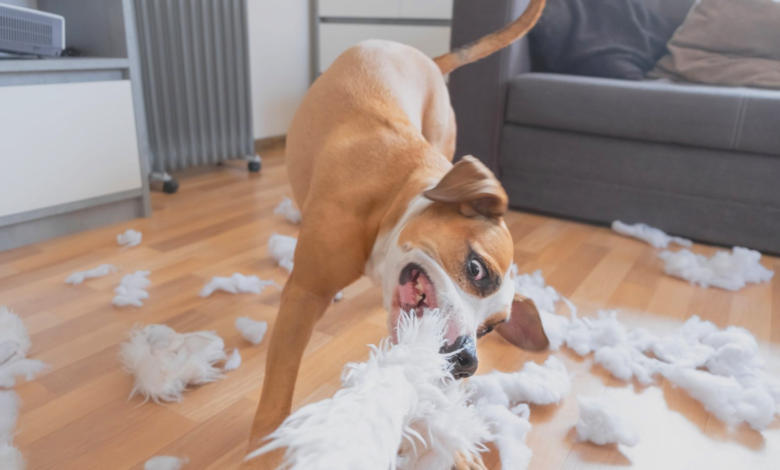
How to Train Your Anxious or Hyperactive Dog 6 Best Training Tips
A hyperactive dog may be gratifying and tough to train. It’s critical to realize that hyperactivity in dogs often indicates the presence of underlying problems like boredom, anxiety, or a lack of exercise. In order to maintain your dog’s health and happiness, it is imperative that you take care of these problems and provide him plenty of mental and physical stimulation.
Tips to Help Your Anxious or Hyperactive Dog
The secret to training your hyperactive dog is to give him regular exercise and playing. This will assist in using extra energy and avert harmful conduct. To keep your dog happy and involved, make sure he has a variety of toys and activities.
In order to spend quality time with your dog, it’s also critical to have frequent sit-downs and obedience classes to teach him etiquette and acceptable behaviour. This will provide him a feeling of order and purpose as well as teach him to concentrate and control his urges.
To avoid boredom and destructive behaviour, it’s also critical to provide your dog frequent exercise and mental stimulation. Regular walks, playing with toys, and obedience training are a few examples of this.
Read More : Mastering the Art of Walking Small Dogs: Essential Tips for Pet Owners
Lastly, to shield your dog from illnesses and parasites, make sure he receives all recommended immunizations and preventive treatment. You can maintain the safety and well-being of your hyperactive dog by following these guidelines.
How to Keep Your Dog Safe?
Particularly if they are very energetic, dogs sometimes exhibit an inquisitive aspect to their personalities. They may approach, sniff, or even bite something they are ignorant of with great ease and naturalness.
All caregivers must make sure that the sections of the home that the dogs are not allowed to enter are closed off and that the dogs are trained to avoid those places. Keeping your dog safe requires giving him a safe and secure environment.
This calls for making sure your yard is securely gated and that your dog is always watched when they play or walk outdoors. To avoid unintentional consumption, it’s also critical to keep potentially harmful objects out of reach, such as cleaning supplies and prescriptions.
The following advice will help you safely and effectively educate your hyperactive dog:
Provide Plenty of Exercise and Mental Stimulation
Dogs who are hyperactive often have a lot of energy, so it’s important to give them plenty of chances to exercise and engage in mental stimulation to help them burn it off.
This might include regular runs, walks, and excursions to the dog park in addition to mental-challenging games and activities like puzzles and training sessions. When exercising or taking your dog outside, it is imperative that you make sure they are on a firm leash.
Use Positive Reinforcement
Treats, compliments, and other prizes are given to excellent behaviour as a kind of training known as positive reinforcement. This may help your dog become more focused and attentive while also teaching them new instructions and behaviours.
Rewarding your dog right away after they display the desired behaviour is crucial when applying positive reinforcement. It is best to choose dog treats that are abundant in nutrients, like bully sticks, since they may improve the general health of the animal. Dog bully sticks are acknowledged for their possible advantages and nutritional worth. This will increase the likelihood that they will repeat the behaviour in the future by helping to reinforce it. To maintain your dog’s motivation and interest, you should also change up the kinds and timing of your treats.
For instance, you may provide praise or a favourite toy as a reward during certain training sessions and treats during others.
Additionally, it’s critical to provide positive reinforcement consistently. This entails refraining from using punishment or negative reinforcement and instead using incentives to promote the same behaviour every time your dog displays it.
It will be simpler for your dog to learn and act in a way that is acceptable to you and other people if you regularly encourage positive behaviour in your dog. This will also assist to set clear limits and expectations.
Establish a Consistent Routine for Your Dogs
Your dog will benefit from structure and predictability that come with a regular daily schedule, which will help them feel less stressed and anxious.
For hyperactive dogs, who may be more prone to nervous or overstimulated behaviour, this may be very beneficial. Additionally, a schedule helps keep your dog from becoming bored or restless, both of which can lead to hyperactivity.
Maintaining a regular schedule may also help you better control your dog’s behaviour and training. For instance, you may schedule your training sessions so that your dog has a chance to relieve itself before beginning a session, in case you are aware that your dog needs to go outside for a pee break at a certain time every day.
This may facilitate your dog’s ability to concentrate and learn while also reducing the likelihood of mishaps and disturbances during training.
Use a Leash and Harness
Using a leash and harness can help you keep your energetic dog under control when you go for walks or exercise. Your dog may avoid rushing into traffic or other hazardous situations by wearing a leash. This is especially crucial for hyperactive dogs, whose high energy and lack of impulse control may make them more prone to dash into danger.
Using a leash may assist you in keeping your dog under control and stop them from acting in an improper or harmful way.
For energetic dogs, who could be harder to control without the extra security of a leash, this is especially crucial.
Be Patient and Persistent
Given that hyperactive dogs often have a lot of energy and are quickly distracted, training one may be difficult. Both you and your dog may get frustrated as a result of their inability to concentrate and learn.
It takes persistence and patience to properly teach a hyperactive dog. This entails being prepared to work with your dog and assist in their learning, even if it takes more time than you would want.
It also entails maintaining consistency in your methods and standards and refusing to give up even if your dog doesn’t react to your directions right away or doesn’t appear interested in learning.
Being adaptable and ready to modify your training strategy to suit your dog’s demands may also be a sign of patience and persistence.
For instance, you may need to divide a training session into smaller, more manageable segments if your dog is unable to concentrate. Alternatively, if your dog becomes easily distracted during training, you may need to figure out how to take away distractions or make the process more fun and exciting for your dog.
Seek Professional Assistance
Consult a professional dog trainer or behaviourist if your dog’s hyperactivity is creating issues in your household or is making it difficult for you to control their behaviour.
In order to control your dog’s hyperactivity and enhance its behaviour, a specialist may provide you individualized training and behaviour modification techniques. Additionally, they may provide you specific guidance, pointers, and methods to assist you control your dog’s hyperactivity and ensure their safety.
Read More : Why Do Cats Knead : 12 Reasons Why Your Cat is Making Biscuits
Conclusion:
Giving your dog the mental and physical stimulation he needs to be happy and healthy is a difficult but rewarding process of training a hyperactive dog. It takes patience, consistency, and a willingness to put in time and effort.
Your hyperactive dog may have a happy, fulfilled life if you work with him and use the appropriate methods to help him learn impulse control and concentration.







